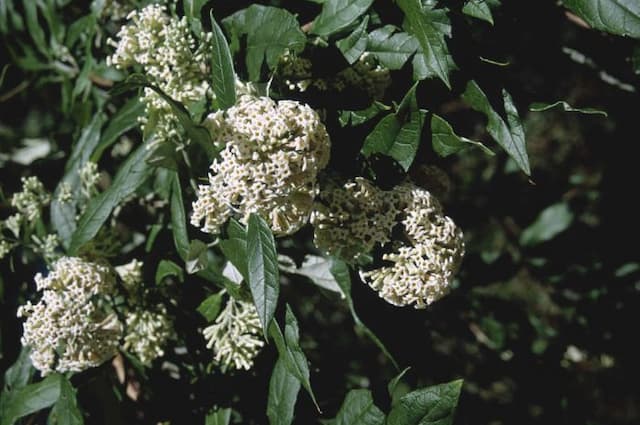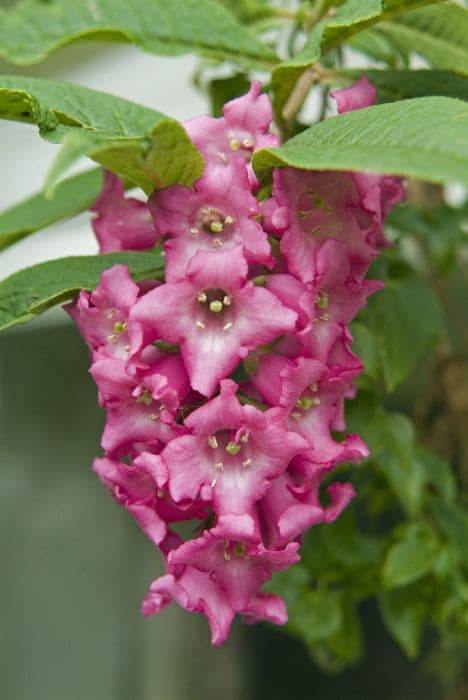Twinspur Diascia 'Hector's Hardy'

ABOUT
Diascia 'Hector's Hardy' is an enchanting perennial known for its abundant displays of flowers. The blossoms are a standout feature, with each one shaped like a little, delicate spout, which gives them a unique, tubular appearance. The flowers come in a variety of colors, often in shades of pink, coral, or salmon, presenting a warm, inviting display. These blooms are typically arranged in loose clusters that grace the tips of the plant's stems, providing a frothy, whimsical look to the overall structure. The foliage of 'Hector's Hardy' is equally attractive, with soft, green leaves that may have a slightly furry or velvety texture. These leaves are small to medium in size and are typically pointed or heart-shaped, creating a nice backdrop that complements the colorful flowers. The plant carries its flowers above this verdant mound of foliage, creating a layered effect that is both lush and plentiful. The overall habit of Diascia 'Hector's Hardy' is graceful and mounded, with a tendency to spread slightly, giving it a full and robust appearance. This characteristic enables it to fill in garden spaces nicely and make an impactful visual statement, even though the individual components of the plant—its leaves and flowers—are delicate and intricately detailed. It is a favorite among gardeners looking to add a touch of softness and charm to their beds, borders, or containers.
About this plant
 Names
NamesSynonyms
Twinspur
Common names
Diascia 'Hector's Hardy'.
 Toxicity
ToxicityTo humans
There is limited information available on the toxicity of the Diascia 'Hector's Hardy' to humans. In the absence of specific data, it is generally advisable to avoid ingestion of ornamental plants. If you suspect poisoning from any plant, seek medical attention promptly and provide details of the plant ingested.
To pets
The toxicity of Diascia 'Hector's Hardy' to pets such as dogs and cats is not well documented. As with humans, ingestion of ornamental plants by pets should be avoided. If you suspect your pet has ingested part of this plant, monitor for any signs of distress or unusual behavior and consult a veterinarian for advice.
 Characteristics
CharacteristicsLife cycle
Perennials
Foliage type
Evergreen
Color of leaves
Green
Flower color
Pink
Height
1 foot (30 cm)
Spread
2 feet (60 cm)
Plant type
Herb
Hardiness zones
9
Native area
South Africa
Benefits
 General Benefits
General Benefits- Attractive to Pollinators - Diascia 'Hector's Hardy', commonly known as Twinspur, is known for attracting bees and butterflies which are important pollinators for gardens and ecosystems.
- Easy to Grow - Twinspur is known for its hardiness and its ability to thrive with minimal care, making it suitable for gardeners of all skill levels.
- Extended Blooming - Offering a long flowering season, Twinspur provides continuous color and interest in the garden from spring to fall.
- Drought Tolerance - Once established, Twinspur exhibits a degree of drought tolerance, reducing the need for frequent watering.
- Compact Growth Habit - This plant typically has a neat, compact growth pattern which makes it ideal for borders, containers, and small garden spaces.
- Color Variety - Twinspur comes in a range of colors, adding versatility and variety to garden designs and color schemes.
- Frost Resistance - 'Hector's Hardy' suggests an enhanced resistance to cold temperatures, potentially extending its growing region.
 Medical Properties
Medical PropertiesThis plant is not used for medical purposes.
 Air-purifying Qualities
Air-purifying QualitiesThis plant is not specifically known for air purifying qualities.
 Other Uses
Other Uses- Photography subject: The delicate blossoms and bright colors of Diascia can serve as an excellent subject for photographers specializing in plant and nature photography.
- Art inspiration: Artists may draw inspiration from the intricate form and hues of Diascia for paintings, drawings, and textile designs.
- Education: Diascia can be used in educational settings to teach botany students about plant structure, reproduction, and the variety of flowering plants.
- Natural dye source: The petals of Diascia, with their rich colors, could potentially be used to create natural dyes for fabrics or crafts.
- Theme gardens: Diascia can be included in theme gardens to represent certain colors or to contribute to a specific garden design theme such as a butterfly garden.
- Companion planting: This plant can be used in companion planting to attract beneficial insects that might prey on garden pests.
- Container gardening: Due to Diascia’s compact growth habit, it is suitable for adding floral variety to balcony gardens or small-space container gardening.
- Wedding decor: The blooms of Diascia can be used to create natural and elegant wedding decor, such as table centerpieces or venue decorations.
- Jewelry making: Dried Diascia flowers can be incorporated into handmade jewelry, such as resin pendants or pressed flower earrings.
- Culinary decoration: While not a common culinary ingredient, the non-toxic flowers of Diascia could be used as decorative garnish for plating dishes in high-end cuisine.
Interesting Facts
 Feng Shui
Feng ShuiThe Diascia is not used in Feng Shui practice.
 Zodiac Sign Compitability
Zodiac Sign CompitabilityThe Diascia is not used in astrology practice.
 Plant Symbolism
Plant Symbolism- Endurance and resilience: The name 'Hector's Hardy' suggests a plant that can withstand challenging conditions, symbolizing the ability to endure and remain strong through tough times.
- Charm and attraction: Diascia, also known as Twinspur, typically represents charm and the power of attraction, possibly due to its bright and appealing flowers.
 Water
WaterTwinspur, or Diascia 'Hector's Hardy', prefers consistently moist soil, so it should be watered regularly. During the growing season, check the top inch of soil and if it is dry to the touch, water the plant thoroughly, using around 16 ounces of water for small pots or up to 1 gallon for larger containers every week, depending on the size of the plant and the environmental conditions. Be careful not to overwater, as this plant is sensitive to waterlogging. In warmer seasons or dryer climates, it may require more frequent watering, while in cooler or wetter conditions, less frequent watering might be necessary. Always provide enough water to soak the root zone.
 Light
LightThe best light condition for Twinspur is full sun to partial shade. This means the plant will thrive in a spot that receives at least 6 hours of direct sunlight a day, but it can also perform well with some afternoon shade, especially in hotter climates. An east or west-facing garden bed or window which gets ample morning or late afternoon sun would be an ideal location.
 Temperature
TemperatureTwinspur plants prefer temperate conditions and are hardy in a range of temperatures. They can survive temperatures as low as 20 degrees Fahrenheit and as high as 80 degrees Fahrenheit, but they perform best when the temperature is between 50 and 70 degrees Fahrenheit. Protecting the plants from frost is important as extreme cold can damage or kill them.
 Pruning
PruningTwinspur benefits from regular pruning to encourage bushier growth and more blooms. Pruning should be done in the early spring or after the plant has finished blooming. Cut back up to one-third of the plant’s height, focusing on removing any dead or weak stems. Deadheading, or the removal of spent flowers, should be done throughout the season to promote continuous flowering.
 Cleaning
CleaningAs needed
 Soil
SoilTwinspur 'Hector's Hardy' prefers well-draining soil with a loamy or sandy texture, peat or compost can be added for better drainage. It thrives in neutral to slightly acidic pH levels, around 6.0 to 7.0.
 Repotting
RepottingTwinspur 'Hector's Hardy' should typically be repotted every 1-2 years, preferably in the spring to give it a fresh start for the growing season.
 Humidity & Misting
Humidity & MistingTwinspur 'Hector's Hardy' does best in moderate humidity conditions, average room humidity is often suitable for this plant.
 Suitable locations
Suitable locationsIndoor
Place it in bright, indirect light and keep the soil moist.
Outdoor
Find a sunny spot, protect from harsh winds, ensure soil drains well.
Hardiness zone
7-9 USDA
 Life cycle
Life cycleDiascia 'Hector's Hardy', commonly known as Twinspur, begins its life cycle as a seed which, when sown in fertile, well-draining soil and given adequate warmth and light, will germinate. After germination, the seedling emerges and grows into a young plant with distinctive foliage and starts to develop a root system. As the Twinspur matures, it undergoes vegetative growth, producing lush leaves and stems that are characteristic of its species. Once the plant has reached a suitable size and environmental conditions are favorable, usually in spring or summer, it enters the flowering stage, where it produces its signature tubular flowers that attract pollinators. After pollination, the flowers will develop into seed pods, containing seeds that can be dispersed to produce new plants. The plant can live for several years, but it may also behave as an annual or biennial depending on the climate, completing its life cycle by dying after seed production, or it can overwinter and resume growth in the next season.
 Propogation
PropogationPropogation time
Spring-Early Summer
Diascia 'Hector's Hardy', commonly known as Twinspur, can be propagated effectively by cuttings, especially during the warmer growing seasons such as spring and summer. To propagate by cuttings, select a healthy, non-flowering shoot and cut a 4 to 6 inch (about 10 to 15 centimeters) length. Strip the lower leaves and dip the cut end into rooting hormone to encourage root development. The cutting should then be inserted into a pot filled with a well-draining soil mix, and the soil should be kept consistently moist. Place the pot in a warm area with indirect sunlight, and in a few weeks, the cutting should develop roots and can eventually be transplanted to its permanent location. This method is popular due to its simplicity and the high success rate in producing new, healthy plants.

![Butterfly bush [Berries and Cream]](/_next/image?url=https%3A%2F%2Fplants-admin.emdemapps.com%2Fimages%2Fplants%2F%2Fimages%2F604b650f667be.png&w=640&q=75)






